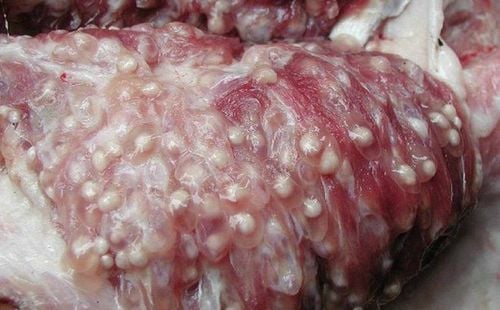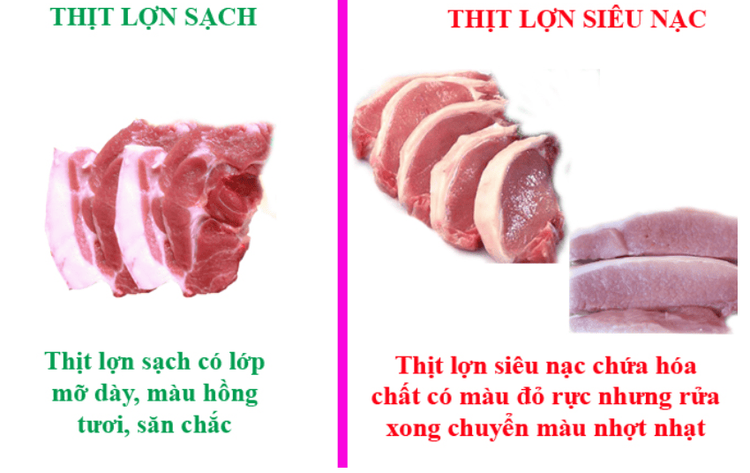This article was professionally consulted by Dr. Mang Thi Phuong Mai, Department of General Medicine & Internal Medicine, Vinmec Nha Trang International Hospital.
Given the ongoing risks of swine diseases such as cysticercosis (pork tapeworm) and African swine fever, along with concerns about unsanitary farming practices, consumers should know how to identify different types of pork. This article will distinguish safe, quality pork from meat contaminated with parasites, growth-promoting substances, preservatives, or disease-causing pathogens. Making informed choices about food safety protects your family's health and helps reduce the risks associated with consuming unsafe meat products.
1. How to Identify Clean Pork vs. Tapeworm-Infected Pork
Tapeworm-infected pork often has large white spots, known as "rice pork", with fibrous or oval-shaped muscle strands. The meat is usually tough and lacks elasticity.
Clean pork is pork that is not raised on growth-enhancing feed, does not contain residual drugs and chemicals at the time of slaughter, is free from parasites and bacteria, and does not contain preservatives. Clean pork usually has a thick skin and fat layer.
There are many ways for consumers to identify clean pork and tapeworm-infected pork. One method to detect and identify pork with tapeworms is to cut the meat along the grain and observe the surface. If the pork contains large white spots the size of a pinhead or has fibrous or oval muscle strands, it has likely been infected with tapeworms. Another way to identify it is by touching the meat: if the pork is hard, lacks elasticity when pressed, and does not feel soft, it may have been treated with urea or borax.
The most common type of tapeworm found in pork is Cysticercus cellulose. When the tapeworm enters the human body, it does not immediately develop into small worms but remains in its larval form. These larvae form moving lumps within the skin and soft tissues. These mobile lumps often appear in areas such as the face, the back of the hands, the back, the buttocks, and the abdomen. Over time, these lumps develop into small nodules or swelling masses, which can cause damage to the central nervous system, leading to cognitive disturbances, partial paralysis, or even coma.
Tapeworm larvae can also migrate to internal organs such as the liver, lungs, and brain, causing symptoms such as abdominal pain, coughing, chest pain, breathing difficulties, and seizures. If the larvae reach the eyes, they may cause eye hemorrhages, reduced vision, and even blindness. When they enter the ear or nasal cavity, they can lead to earaches and nasal inflammation.
In addition to the risk of tapeworm infection, pork may also contain growth-enhancing substances, lean-meat additives from feed, or be soaked in preservatives.

2. How to Identify Clean Pork vs. growth-promoting substances or Lean Pork
Chemically treated lean pork often has a stronger fishy smell than clean pork. The fat layer under the skin is usually thinner, and the lean meat and fat are separated. Clean pork has a fresh pinkish color, whereas pork containing lean-enhancing chemicals often appears dark red, with a bright and glossy surface. The pig's skin may show red spots resembling subcutaneous hemorrhages.
Another way to identify growth-promoting substances in pork is to cut a piece about 3-4 cm thick. If the meat cannot stand upright, it has likely been fed with growth-enhancing substances.
Clean pork, when boiled, will produce clear broth with little residue. When cooked, the meat expands, does not release excessive water, and has a pleasant aroma. In contrast, lean-enhanced or growth-stimulated pork, when boiled, often produces a lot of scum, has a foul smell, and, when stir-fried, releases excessive water, making the meat very dry.

3. How to Identify Clean Pork from Preservative-Treated Meat
Preservative-treated pork usually has a bright red color, firm and stiff texture, and lacks elasticity when pressed. When cut more deeply, the meat may feel mushy, release fluid, appear slightly darkened, and have a strong odor. When washed, this type of meat will turn pale, emit an unpleasant fishy smell, and its fat often appears yellow. When cooked, the broth will be very cloudy with a foul odor, and the fat on the surface will separate into small round droplets instead of forming large fat clumps like fresh pork.
4. How to Identify Clean Pork from African Swine Fever-Infected Meat
Pigs infected with African Swine Fever (ASF) often have subcutaneous hemorrhages resembling mosquito bites, especially on the ear rims.
The pig's legs, abdomen, and chest may appear bluish-purple. Upon slaughter, the body cavities contain bloody fluid. The entire internal organs and body exhibit hemorrhages, the spleen is swollen, lymph nodes are significantly enlarged, lungs do not collapse, the trachea contains blood and foam, kidneys show hemorrhages, the stomach lining has ulcers and intestines are obstructed with blood.
Consumers can identify ASF-infected pork by visual inspection. Clean pork has a naturally fresh red color, bright white fat, and skin without red, blue, or abnormal spots. The meat should not indent or leak fluid when pressed with a finger.
If pork exhibits unusual colors such as brown, gray, dark red, or a slight greenish tint, with hemorrhagic spots on the skin, darkened ears, and a slimy or watery texture when touched, it is likely spoiled or ASF-infected pork. Pork should be cooked thoroughly, as ASF bacteria are killed at 70°C.
Always consume fully cooked food and boiled water. Avoid eating raw pig’s blood pudding or undercooked pork. Before cooking, wash the meat with diluted salt water and wash your hands thoroughly with soap before and after cooking. Consume cooked food immediately and avoid leaving it out for too long to prevent bacterial contamination. Do not mix cooked food with raw food or use the same utensils for both.
Currently, many areas in our country have reported ASF-infected pigs. However, some businesses continue to slaughter, process, and chemically treat the meat for sale. Therefore, people should be aware of the ways to distinguish clean pork from chemically preserved pork mentioned above. Consumers should purchase meat from reputable suppliers such as supermarkets and certified clean meat stores to avoid buying diseased pork. Do not opt for cheaper meat from unknown sources, especially in unhygienic places with many flies and poor covering.
Please dial HOTLINE for more information or register for an appointment HERE. Download MyVinmec app to make appointments faster and to manage your bookings easily.
To arrange an appointment, please call HOTLINE or make your reservation directly HERE. You may also download the MyVinmec app to schedule appointments faster and manage your reservations more conveniently.


